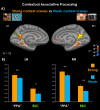Scenes unseen: the parahippocampal cortex intrinsically subserves contextual associations, not scenes or places per se
- PMID: 18716212
- PMCID: PMC2707255
- DOI: 10.1523/JNEUROSCI.0987-08.2008
Scenes unseen: the parahippocampal cortex intrinsically subserves contextual associations, not scenes or places per se
Abstract
The parahippocampal cortex (PHC) has been implicated in both place/scene processing and episodic memory. We proposed that this region should instead be seen as intrinsically mediating contextual associations and not place/scene processing or episodic memory exclusively. Given that place/scene processing and episodic memory both rely on associations, this modified framework provides a platform for reconciling what seemed like different roles assigned to the same region. Comparing scenes with scenes, we show here that the PHC responds significantly more strongly to scenes with rich contextual associations compared with scenes of equal visual qualities but less associations. This result adds unequivocal support to the view that the PHC mediates contextual associations in general rather than places or scenes proper, and necessitates a revision of the current view that the PHC contains a dedicated place/scenes "module."
Figures



References
-
- Aguirre GK, Detre JA, Alsop DC, D'Esposito M. The parahippocampus subserves topographical learning in man. Cereb Cortex. 1996;6:823–829. - PubMed
-
- Aminoff E, Gronau N, Bar M. The parahippocampal cortex mediates spatial and nonspatial associations. Cereb Cortex. 2007;17:1493–1503. - PubMed
-
- Bar M. Visual objects in context. Nat Rev Neurosci. 2004;5:617–629. - PubMed
Publication types
MeSH terms
Grants and funding
LinkOut - more resources
Full Text Sources
Medical
